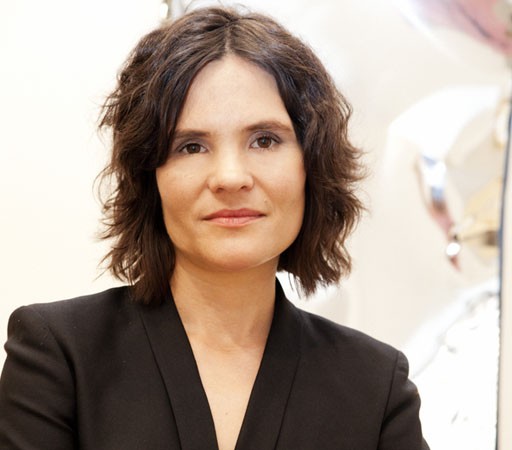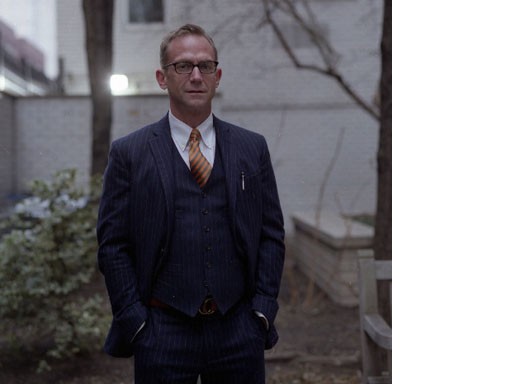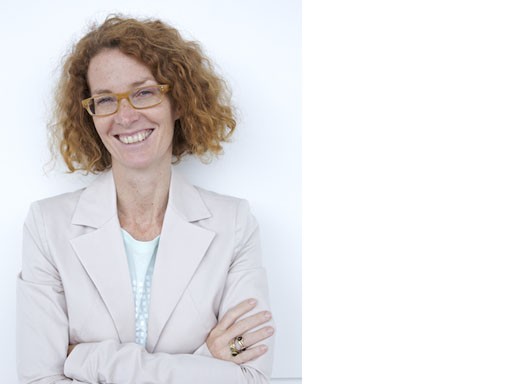This weekend the New Art Dealers Alliance is helping Frieze reorient the New York art fair landscape by opening NADA New York, its first fair in the global art capital. Situated in the former Dia Art Foundation building—a space now known as the home of the Independent art fair in March—the new event will be a continuation of NADA's mission to expose collectors to the best emerging artists and galleries, something it has been doing with edgy panache since debuting in Miami in 2003 as a satellite to Art Basel Miami Beach. The New York edition debuts at a time of growth for NADA, which last summer expanded to Hudson, New York, with a rambunctious fair in a former factory building, and last month launched NADA Cologne as an adjunct to the granddaddy of all art fairs, Art Cologne.
It's also a period of change for NADA director Heather Hubbs, who in addition to rolling out two new art fairs this spring also recently had a baby and got married. Hubbs took a moment from her busy—and that's an understatement—schedule to talk to Artspace editor-in-chief Andrew M. Goldstein about why she decided to bring her fair to New York, how she sees it coexisting with Frieze, and what else the future holds for NADA. For those who can't make it to NADA, Artspace has curated a collection of works from our partner galleries exhibiting at the fair, which you can find at right.
Click here to also read our interview with Frieze director Amanda Sharp on her new NYC fair.
Since launching in Miami in 2003, NADA has been a central draw during the week of Art Basel Miami Beach, introducing new galleries and artists to fairgoers and doing great business in the process. Now you're coming to New York. Tell me about the genesis of this expansion.
The idea of doing a fair in New York has been something that's been on the table with NADA for many, many years. It's been a point of discussion with three different boards that I've gone through during my time at NADA, and there have been various reasons why we didn't do it in the past. The reason why we chose to do it this year had to do with a majority vote from the board of directors, and then other things were just completely practical, logistical considerations. And this year it just seemed right. In the past so many NADA people did the Armory Show, and obviously there's been a lot of shifting going on with fairs throughout the year, and things are just different now. It seemed like a good year to try it. We've been doing a lot of experimental things, like NADA Hudson last year and NADA Cologne, and now New York. The one nice thing about NADA is that we're a small nonprofit, and for us to do these shows and try to these things is somewhat easy for us to do in that we don't have to go through a bunch of red tape or get approval from a chain of people—we can just have meetings and decide whether or not we want to do things, which I think frees us up to be more experimental. Frieze coming here is a good opportunity to get on board, to do something while they're here. The biggest thing was deciding whether we should wait a year—if it was too soon and we should wait and see. But there was enough demand for it from our board members and also from other galleries, other members, and even collectors and curators who were saying that NADA should do something. And the building was available, and it's in a great location. So it seemed like an opportunity we should take advantage of, and we went for it.
When did you first hear that Frieze was going to be coming this year?
I heard rumors about it a long time ago, at least a year before they announced officially that they were doing something. I only heard these things through other gallery owners. I never heard anything from Frieze itself. But I wasn't surprised. I think that when Independent came along it was a sign that people were looking for alternatives, so it wasn't surprising that Frieze would take advantage of that opportunity and try something in New York.
It's plain to see that you're right about people looking for alternatives, considering that .
Yeah. There are a few people who are sharing booths, so there aren't necessarily 67 booths, but there are definitely plenty of good people who were looking for an opportunity.
You've lined up 67 exhibitors for your first New York fair, which is just a few short of the number you had in Miami last year and almost as many exhibitors as Frieze NYC is showing. This clearly supports the idea that people are hungry for another art fair in New York City. Why do you think so many galleries are looking for an alternative to the Armory Show?
I think that when it comes to galleries, especially younger New York galleries and galleries from outside the city, everyone wants to get their foot in New York. New York is still the headquarters for this type of business. So for galleries outside the state and for younger galleries that are trying to spread their name, having exposure in New York is a really amazing and quick way to do that. There are always going to be galleries that want to show here. And I still think it remains to be seen what's going to happen with the Armory Show—it's so hard to anticipate what's going to happen with these fairs anymore. There's been so many things in flux for the past couple of years, and there's been all these predictions about what's going to happen, and I feel like it's one of those things where everything's been thrown up in the air and we might just have to see where it lands. I think that the bottom line is that people want a good fair in New York, and there's room for that. Who grabs the reins and takes hold moving forward remains to be seen. I think Frieze clearly does a great job in London and people like going to that fair, some really great galleries do that fair, and their lineup for this year looks amazing. We'll just have to see what happens.
It's interesting to think about NADA alongside Frieze, because NADA has such an appealing niche as the curated indie satellite fair to Art Basel Miami Beach. The Independent art fair has managed to carve out that same position in regard to the Armory Show. But now that you'll be the concomitant fair during Frieze NYC, you can see there's a lot of commonality between your fairs, with several traditional NADA galleries like James Fuentes and Canada doing Frieze this year. How do you see NADA as relating to Frieze?
We're nonprofit, we're a lot smaller, and we don't have the various sections like Frame and Focus that they have. We don't do that—it's kind of like: we have two booth sizes. And there are no real restrictions on the two sizes, in terms of only allowing galleries to show this in one size and this in another.
Frieze has the biggest blue-chip galleries in the world, like White Cube and David Zwirner. Do you see a price point as being a key differentiator in terms of the experience collectors will have going to NADA versus going to Frieze?
That could be a general difference that people have experienced in the past. There's definitely been a push among our organization and my board for Miami to really break that—though not to totally dismiss that idea, because that's definitely an element of NADA. But we're trying to get away from NADA being seen as a satellite fair or stepping stone to something else. We're trying to solidify this idea that NADA is its own thing, and is just as valuable and can stand on its own in its own way. And that is something that is a little further along in Miami, but we've also been doing the fair in Miami for almost eight years, whereas this is our first time in New York and we're kind of playing the field, seeing what it will be like. Who knows, maybe the New York fair will evolve into something entirely different than the Miami fair. I don't know that they have to have necessarily the same identity. They could; they may not. I don't personally see any reason why they have to. If they have different identities that wouldn't have to detract from the other. To me it seems fairs exist on their own in their different cities, and that's okay.
What was your selection process like for the New York fair?
It's a similar process as we do for Miami and as we did Cologne. We have a group of gallery owners and it's an open application process where anybody can apply and the applications are reviewed and final selections made by a committee. And the committees are different—the committee from Miami is different than the committee for Cologne. For New York it was two people from New York, one from Chicago, and two from Europe.
Now, you're in the former Dia building, which everybody loves. It's got incredible history and it shows art really well. Then Frieze is on Randall's Island. What do you make of the Randall's Island location? Will it be possible to have traffic going from one fair to another?
I think it remains to be seen if they can do it in one day. I'm hoping so. I hope that people can go back and forth in one day—go to one and then go to another. I'm thinking that people will definitely make the attempt like they do during Armory when everybody goes to Chelsea because they go to the galleries and want to see the shows. So I think that that will happen. People will go to both locations. Everybody's going to go to Frieze—everybody's going to want to see it. I'm super curious to see it. No one's ever done what Frieze is doing on Randall's Island, so I think the speculation is warranted. But it could be fine, who knows. I've never been to Randall's Island, so I can't even comment on my experience there when nothing's going on, but if there's one thing about New Yorkers it's that they're not afraid to move around the city.
What, in your eyes, would make this inaugural NADA New York fair a success? What kind of targets are you angling to hit?
My biggest concern is always that the galleries sell, so I'm hoping that collectors come and like what they see and make purchases. The bottom line is this is a business and these guys are here to sell and make money, and it's our role to help facilitate those kinds of opportunities. So that's the number one thing. And then, after that, I hope that visitors and exhibitors have a good time, since an art fair can be grueling to participate in but we really do put a lot of effort and time and thought into making that experience as nice as possible for the exhibitors. At the end of the day, NADA is a nonprofit, member-based organization, and our members are made up of the same kinds of people that participate in our fairs. So while fairs are very much for the public and for buyers, it's also for the exhibitors, so it's important that they're taken care of. And it's extra-important that they're taken care of at NADA, because this is our constituency that we're talking about and it's part of our mission.
What was your impression of the first NADA Cologne's performance?
Well I didn't get to go because I was in the middle of having a baby, but my staff went over and I heard mostly good things. I think people had a good time. There were sales, some people did better than others. That kind of thing happens at every fair: some people sell very well, others don't sell as well. I think it was a good fair. But, again, I don't want to comment too much on it because I haven't had a chance to recap with Dan Hug, the director of Art Cologne. I don't know what our plan is moving forward because I haven't had a chance to sit down and talk with him. But the feedback was very good and I heard Art Cologne looked the best it had for awhile, so I think that definitely we're on the right track somehow. I'm sure there are going to be some things that need to be tweaked a bit moving forward, but overall I think it was a good start.
Last summer you did your first NADA Hudson, holding an art fair in an old factory building in upstate New York, which was a lot of fun. But what's next on the horizon? Are we going to see other new moves in the future?
Well, we're definitely planning to do Hudson again this year. It will be July 28 to 29 at the same location, the Basilica. We just sent out the application call for that, and we'll know more about what's going to happen at the end of May, early June. But we're definitely going to do it. Other than that, there's Miami coming up.
Q&ANADA NYC's Heather Hubbs on the Debut Edition






















